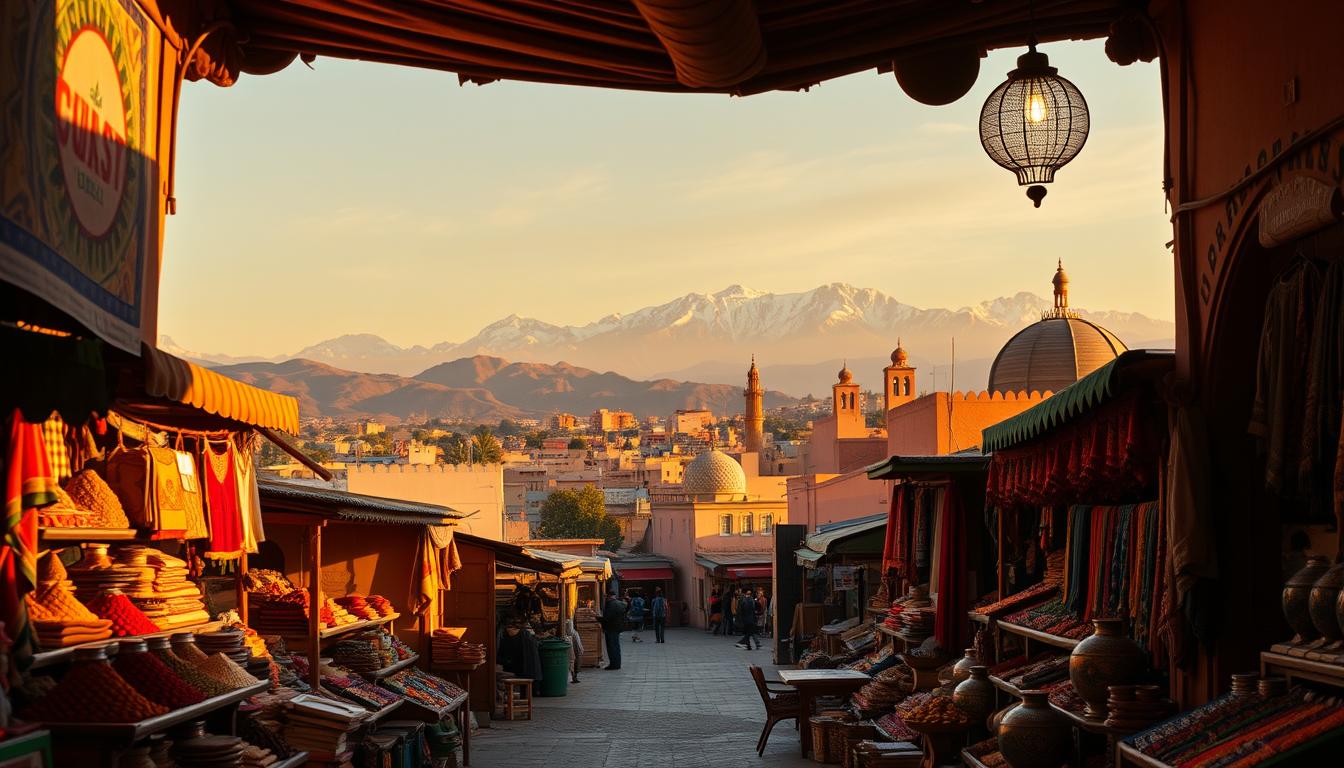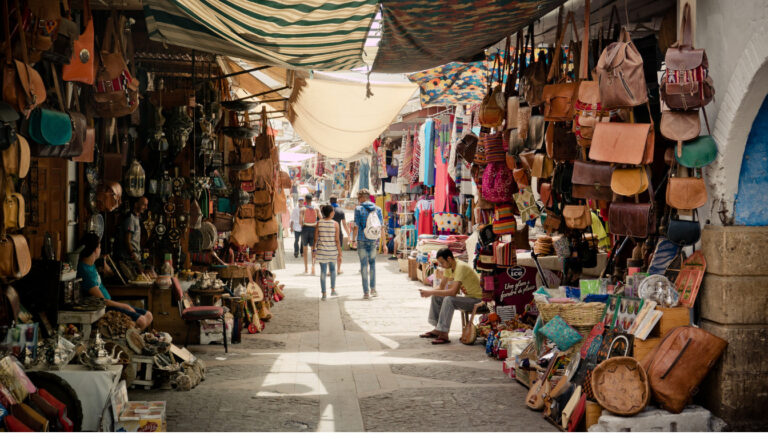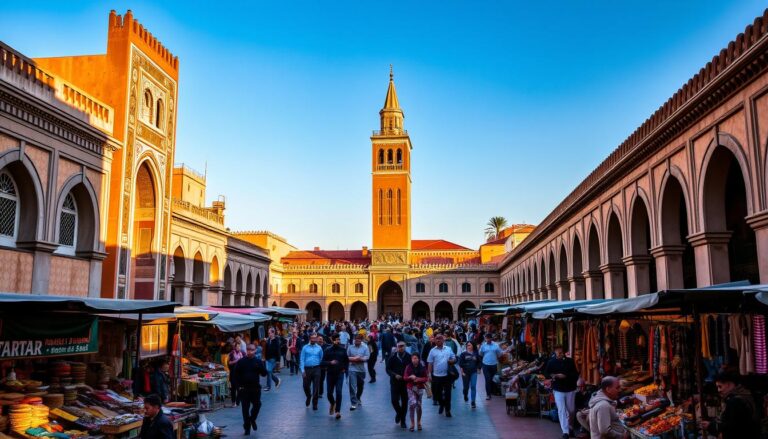Did you know Morocco draws millions of tourists each year? They come for its rich culture, beautiful landscapes, and lively events. Understanding the best time to visit morocco can make your trip even better.
Knowing Morocco’s climate is key for a great trip. The ideal season in Morocco is spring (mid-March to May) or fall (September to October). These times offer mild and pleasant weather. It’s perfect for exploring souks, historic sites, and natural wonders.
Looking for Morocco travel tips or the best visit time? Keep the weather and events in mind. It will make your trip unforgettable.
Key Takeaways
- Spring (mid-March to May) is one of the best times to visit Morocco.
- Fall (September to October) offers pleasant weather ideal for tourism.
- Understanding Morocco’s climate helps in planning a better trip.
- Morocco’s events and festivals are a significant part of its culture.
- Visiting during the ideal season enhances your overall travel experience.
Understanding Morocco’s Climate and Seasons
Planning your trip to Morocco? Knowing its climate is key. Morocco’s climate changes a lot from one place to another. It’s a place full of surprises.
Morocco’s Diverse Geographic Regions
Morocco has coastlines, mountains, and deserts. Each area has its own weather. This makes Morocco a great place to explore.
Coastal Mediterranean Climate
Cities like Casablanca and Rabat have a Mediterranean climate. They have mild winters and warm summers. It’s perfect for those who like the weather just right.
Atlas Mountains Weather Patterns
The Atlas Mountains have a different climate. They get colder winters and cooler summers. It’s a cool place to escape the heat.
Desert Climate Conditions
The desert, like the Sahara, is very hot during the day. But it gets cold at night. You need to plan carefully to visit.
The Four Distinct Seasons
Morocco has four seasons, each with its own charm. Knowing about these seasons helps plan your trip.
Temperature Variations Throughout the Year
Temperatures change a lot with the seasons. Winters are cold, summers are hot. Spring and autumn are nice and mild.
Rainfall Patterns and Humidity Levels
Most rain falls in winter. Humidity changes in different areas. This affects the weather in Morocco.
Spring in Morocco: March to May
Spring in Morocco is a colorful time, with blooming landscapes and cultural festivals. It’s a perfect season to visit, with nice weather and lots of cultural events.
Weather Patterns and Temperatures
Spring in Morocco has mild temperatures, making it great for exploring. The weather changes depending on the region.
Average Temperatures by Region
In the north, it’s between 15°C and 20°C (59°F to 68°F). The south can get up to 25°C (77°F). The Atlas Mountains are cooler, with chilly nights.
Rainfall Expectations
Spring is mostly dry, but March might see some rain. The rain doesn’t last long, leaving plenty of sunshine.
Spring Festivals and Cultural Events
Morocco celebrates many festivals in spring, showing off its culture.
Rose Festival in Kelaat M’Gouna
The Rose Festival is a big deal, with rose-filled valleys. It celebrates the harvest with music, dance, and local goods.
International Nomads Festival
The International Nomads Festival in Errachidia is also important. It highlights nomadic culture with performances, crafts, and camel racing.
Best Spring Activities and Destinations
Spring is great for outdoor fun and seeing Morocco’s varied landscapes.
Desert Experiences Before Summer Heat
Desert adventures are perfect in spring, avoiding the summer heat. It’s a great time for camel treks and desert camping.
Mountain Hiking Opportunities
The mild weather is ideal for hiking in the Atlas Mountains. Trails offer stunning views and chances to meet local Berbers.
Summer in Morocco: June to August
Summer in Morocco brings intense heat, mainly in cities like Marrakech and Fez. But, the coastal areas offer a cool break. This season is perfect for those who love warm weather and lively cultural events.
Managing the Heat: Coastal vs. Inland Areas
Summer in Morocco can be tough due to the high temperatures, more so in inland areas. Cities like Marrakech and Fez face extreme heat during this time.
Temperature Extremes in Marrakech and Fez
Marrakech and Fez see some of the highest temperatures, often over 40°C (104°F). Visitors should drink plenty of water and take breaks in cool or air-conditioned spots.
Cooler Coastal Retreats
Coastal towns like Essaouira and Rabat have cooler weather, with temperatures between 25-30°C (77-86°F). They’re great for those wanting to avoid the inland heat.
Summer Festivals and Celebrations
Summer is a great time to see Morocco’s rich culture through its festivals.
Gnaoua World Music Festival
The Gnaoua World Music Festival in Essaouira is a summer highlight. It draws music fans worldwide with its mix of Gnaoua and international music.
Fez Festival of World Sacred Music
The Fez Festival of World Sacred Music is another big event. It celebrates spiritual music from different cultures, providing a cool break from the summer heat.
Recommended Summer Destinations
Morocco has many great places for summer visits, from beach towns to mountain retreats.
Beach Towns and Coastal Escapes
Towns like Taghazout and Sidi Ifni are known for their beautiful beaches and surfing. Cities like Rabat offer beach fun and cultural experiences.
Mountain Retreats for Cooler Temperatures
The Atlas Mountains are perfect for escaping the heat. They offer cooler temperatures and beautiful landscapes for hiking and trekking.
| Destination | Average Summer Temperature | Main Attractions |
|---|---|---|
| Marrakech | 38°C (100°F) | Historic Medina, Jardin Majorelle |
| Essaouira | 26°C (79°F) | Beaches, Gnaoua World Music Festival |
| Fez | 39°C (102°F) | Ancient Medina, Al-Attarine Madrasa |
| Rabat | 28°C (82°F) | Casablanca Beach, Kasbah of the Udayas |
Autumn in Morocco: September to November
Autumn in Morocco is a great time to visit. The weather is comfortable, and there are exciting cultural events. The country becomes vibrant, perfect for exploring its landscapes and culture.
Weather Conditions and Comfort Levels
Autumn in Morocco has pleasant weather. The temperatures drop from the summer highs. This makes it comfortable for sightseeing and outdoor activities.
Dropping Temperatures and Pleasant Days
September and October have warm but manageable temperatures. They range from 25°C to 28°C (77°F to 82°F). November brings even cooler temperatures, making it great for city and countryside exploration.
Early Autumn Rain Patterns
Autumn is mostly dry, but occasional rain showers can happen. These are usually short and won’t ruin your plans.
Autumn Harvest Festivals
Autumn in Morocco is a time for harvest festivals. These events offer a unique look into Moroccan culture. They are definitely worth experiencing.
Date Harvest in the Oases
The date harvest season is a big event in the oases. Locals gather to collect dates. Visitors can see this traditional process and enjoy local hospitality.
Erfoud Date Festival
The Erfoud Date Festival is a highlight of autumn. It celebrates the date harvest with music, dance, and traditional foods. It’s a great way to dive into local culture.
Ideal Autumn Itineraries
Autumn is a great time to explore Morocco’s diverse regions. From desert landscapes to vibrant cities, there’s plenty to see.
Desert and Southern Morocco Exploration
The desert regions are appealing in autumn. The comfortable temperatures are perfect for camel treks and desert camping.
City Tours in Comfortable Temperatures
Cities like Marrakech, Fez, and Rabat are great in autumn. The temperatures are comfortable for exploring historic sites and cultural attractions.
| Region | Average Temperature (°C) | Festivals/Events |
|---|---|---|
| Marrakech | 25-28 | Marrakech International Film Festival (December, but preparations start in autumn) |
| Oases | 22-25 | Date Harvest Festival |
| Erfoud | 23-26 | Erfoud Date Festival |
Winter in Morocco: December to February
Winter in Morocco, from December to February, is a time of varied climates. This makes it an interesting time to visit. You can see everything from cold mountains to warm deserts.
Climate Variations by Region
Morocco’s different landscapes mean winter weather changes a lot. Each area has its own unique weather.
Coastal Winter Conditions
The coast, like Casablanca and Rabat, has mild winters. Temperatures are between 45°F and 65°F (7°C to 18°C).
Mountain Snow and Cold
The Atlas Mountains get a lot of snow. This makes them perfect for skiing and snowboarding. It can get very cold, great for winter sports.
Desert Winter Temperatures
The deserts, such as Merzouga and Zagora, have mild winters. Daytime temperatures can reach 68°F (20°C). It’s a great time for desert adventures.
Winter Festivals and Holiday Celebrations
Morocco has many festivals in winter. These add to the cultural richness of your visit.
Moroccan Independence Day
This national holiday is on January 11th. It celebrates Morocco’s freedom from France.
International Film Festival of Marrakech
This film festival, in December, shows Moroccan and international films. It’s a big event.
Winter Activities from Skiing to Desert Trips
Winter is a great time for activities in Morocco.
Skiing in the Atlas Mountains
The Atlas Mountains have some of the best skiing in North Africa. Resorts like Oukaïmeden have slopes for all levels.
Desert Experiences with Mild Daytime Temperatures
Winter is perfect for camel treks, desert camping, and exploring the Sahara. The mild sun makes it ideal.
| Region | Average Temperature (°F) | Activities |
|---|---|---|
| Coastal | 45-65 | City tours, beach walks |
| Mountains | 32-50 | Skiing, snowboarding |
| Desert | 50-68 | Desert trips, camel treks |
Morocco’s diverse climates and cultural events make winter special. It offers something for everyone.
The Best Time to Visit Morocco for Different Experiences
Planning your trip to Morocco means thinking about the best time for your activities. Morocco has different landscapes and climates. So, the best time to visit changes based on what you want to do.
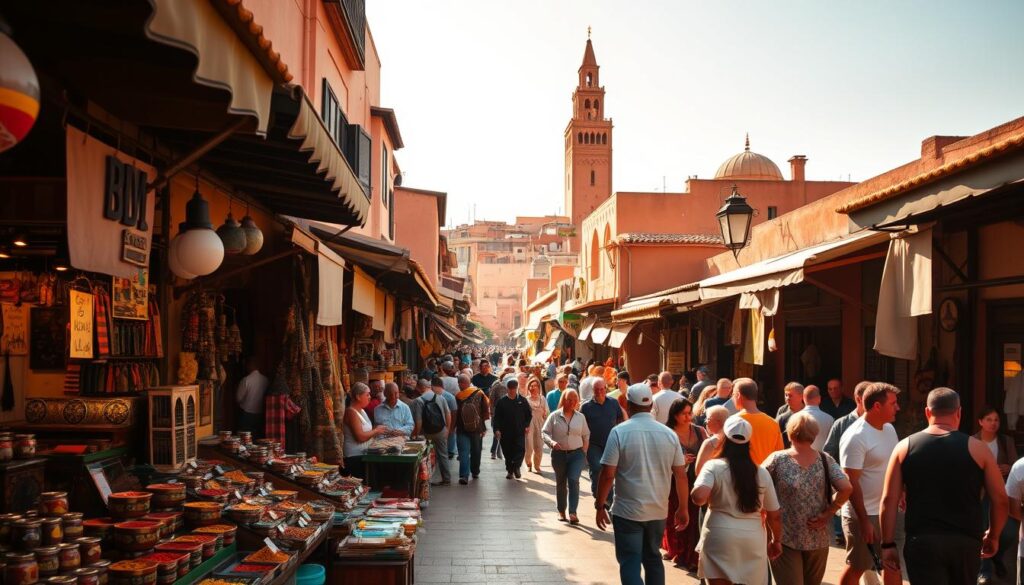
Desert Adventures: When to Visit the Sahara
The Sahara Desert is a big draw in Morocco. But, the best time to go depends on how you handle the heat.
Optimal Months for Comfort and Scenery
The best months for the Sahara are October to November and March to April. These times have mild temperatures. It’s perfect for camel rides and desert camping.
Avoiding Sandstorms and Extreme Heat
Avoid summer (June to August) because it’s too hot. Sandstorms are common in spring and summer. Always check the weather before you go.
Coastal Experiences: Best Months for Beaches
Morocco’s coast has beautiful beaches and a calm vibe. The best time for the coast depends on what you plan to do.
Swimming Seasons by Coastal Region
Swimming seasons change along the coast. Agadir in the south is nice all year. In the north, June to September is best for swimming.
Surfing Conditions Throughout the Year
Surfers will find great waves in places like Taghazout. The best surfing is from September to April when the waves are big.
Mountain Excursions: Ideal Hiking Seasons
Exploring Morocco’s mountains is great. But, the best time varies by region.
High Atlas Trekking Windows
The High Atlas mountains are best in spring (March to May) and autumn (September to November). The weather is mild, and trails are open.
Rif Mountains Exploration Timing
The Rif Mountains in the north are lovely in spring and early summer. They offer green landscapes and comfortable weather.
City Explorations: Comfortable Times for Urban Tours
Morocco’s cities, like Marrakech and Fez, are must-sees. The best time to visit these cities is when it’s not too hot.
Navigating Marrakech and Fez Comfortably
The best times for Marrakech and Fez are spring (March to May) and autumn (September to November). The weather is easier to handle then.
Best Times for Shopping in the Medinas
Shopping in medinas is fun all year, but avoid summer. Visit early morning or late evening to miss the heat and crowds.
As “Morocco is a land of diverse experiences”, a travel enthusiast says,
“the key to a successful trip is planning according to your interests and the activities you enjoy.”
Major Moroccan Festivals and Events Calendar
Planning a trip to Morocco? Timing it with a festival or event can make your trip better. Morocco’s festivals show its rich culture, with religious, cultural, and music events.
Religious Celebrations and Their Dates
Morocco is mostly Muslim, so many big events are religious. Knowing these can help you plan and join in local traditions.
Ramadan Timing and Considerations
Ramadan is a big deal in Morocco, with fasting from dawn to sunset. Restaurants close during the day, but evenings are full of food and fun. Traveling during Ramadan can be special, but respect local ways.
Eid al-Fitr and Eid al-Adha Celebrations
Eid al-Fitr ends Ramadan, and Eid al-Adha honors Abraham. Both are big with food, music, and prayers. Joining these can be a trip highlight.
Cultural and Music Festivals
Morocco’s festivals show its lively arts scene. They feature local and international talent, giving a peek into its culture.
Essaouira Gnaoua Festival
The Essaouira Gnaoua Festival celebrates Gnaoua music from Africa. It has live shows, workshops, and cultural displays, great for music fans.
Marrakech Popular Arts Festival
This Marrakech festival celebrates Moroccan arts with music, dance, and theater. It’s a chance to see the country’s cultural variety.
Regional Celebrations Worth Planning Around
Morocco also has many regional celebrations. These give a look into local traditions and community life.
Imilchil Marriage Festival
The Imilchil Marriage Festival is special, with Berber tribes celebrating marriage. It’s a unique cultural experience.
Moussem of Tan-Tan
The Moussem of Tan-Tan is a cultural festival with tribes from Morocco and beyond. It has music, dance, and crafts, for a rich cultural experience.
Regional Weather Guide: Where to Go When
Morocco’s weather changes a lot depending on where you are. Knowing this helps plan your trip better.
Marrakech and Central Morocco
Marrakech is known for its lively culture and markets. It has a desert climate. The best times to visit are spring (March to May) or autumn (September to November).
Best Months to Visit Marrakech
April, May, September, and October are the best months to visit Marrakech. The weather is nice for exploring the city.
Day Trips from Marrakech by Season
Spring and autumn are great for trips to the Atlas Mountains. Summer is too hot, and winters can be cold in the mountains.
Coastal Cities: Casablanca, Rabat, and Essaouira
The coastal cities have a milder climate than inland areas. Casablanca and Rabat have mild winters and warm summers.
Seasonal Differences Along the Coast
Essaouira is known for its windy summers. The coastal areas are nice in spring and autumn.
Wind Patterns in Essaouira
Essaouira’s winds make it great for surfers and windsurfers, mainly in summer.
| Region | Best Time to Visit | Weather Conditions |
|---|---|---|
| Marrakech | Spring/Autumn | Mild Temperatures |
| Coastal Cities | Spring/Summer | Mild Winters, Warm Summers |
| Northern Morocco | Spring/Autumn | Mediterranean Climate |
Northern Morocco: Tangier and Chefchaouen
Northern Morocco has a Mediterranean climate. It has mild winters and warm summers. Chefchaouen is lovely in spring and autumn.
Mediterranean Climate Patterns
Winters in this region have moderate rainfall. Spring is beautiful with lush landscapes.
Best Times to Photograph the Blue City
Chefchaouen looks best in the early morning or late afternoon. The light then makes its blue buildings stand out.
Southern Morocco and the Desert Regions
The desert regions are best visited in cooler months. This avoids the extreme heat.
Ouarzazate and Film Studios Visitation
Ouarzazate is nice in spring and autumn. It’s a good time to visit the film studios.
Merzouga and Erg Chebbi Dunes Timing
Merzouga and Erg Chebbi dunes are best in spring or autumn. This makes desert camping more comfortable.
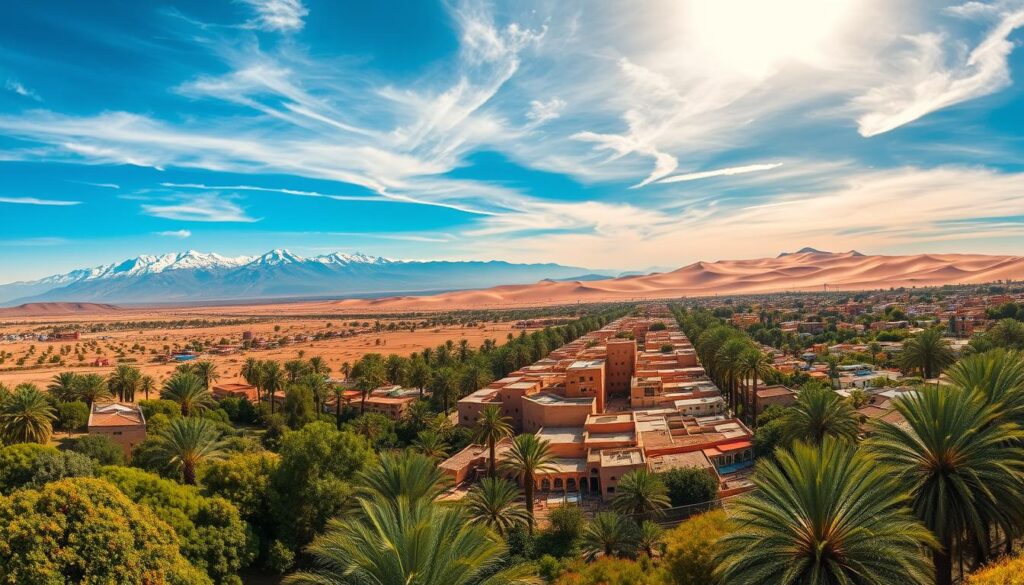
Travel Considerations for UK Visitors
Planning a trip to Morocco involves several key factors. As a UK visitor, knowing these can enhance your travel experience.
Flight Options and Pricing
Direct flights from UK airports to Moroccan cities like Marrakech and Casablanca are available. Keep in mind that prices change with the seasons. Booking early can get you a better deal.
Direct Routes and Seasonal Prices
Many UK airports offer direct flights to Morocco. Prices are higher during peak season. So, plan your visit to save on flights.
Peak vs. Off-Season Tourism
Peak season means more people at popular spots. For a quieter trip, try the off-season. It’s also cheaper.
Avoiding Crowds and Saving Money
Visiting less busy times can make your trip more peaceful. Off-season travel also saves money on places to stay and activities.
Ramadan and Its Impact on Travel
Ramadan changes your dining options during fasting hours. Yet, it offers a chance to experience local culture, like breaking the fast together.
Considering these points can help plan a better trip to Morocco. Whether you’re looking for travel tips or want to avoid crowds, being informed is key.

